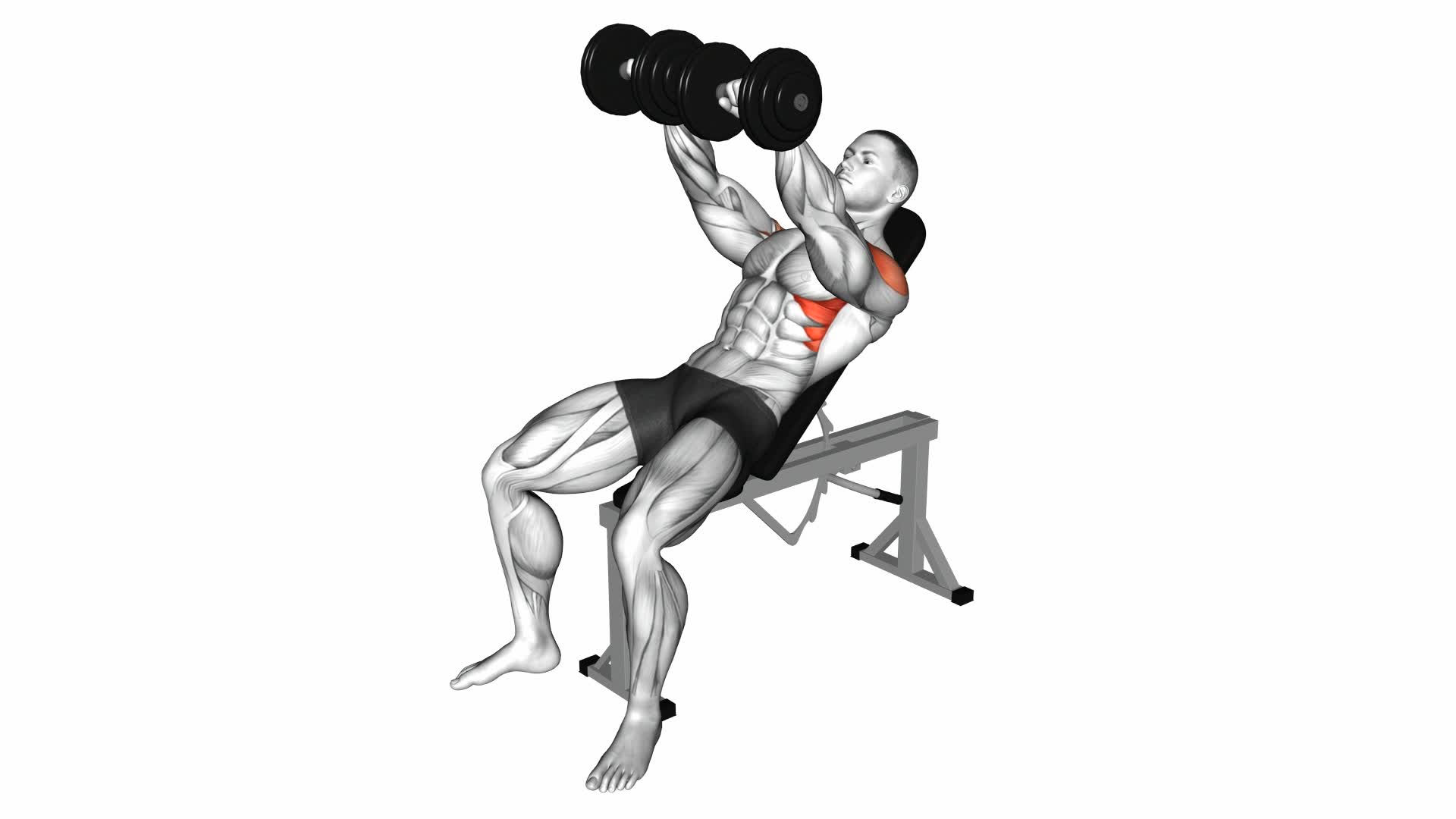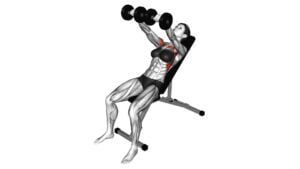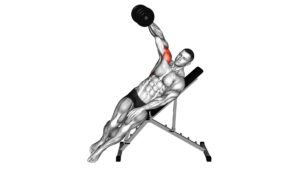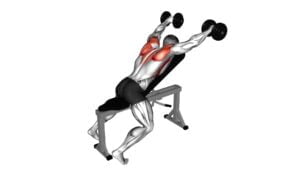Dumbbell Incline Front Raise – Video Exercise Guide & Tips

Looking to strengthen and tone your shoulders? Look no further than the dumbbell incline front raise. This exercise targets the front deltoids, helping you achieve a sculpted upper body.
Watch This Exercise Video
In this video exercise guide, we'll show you the proper form and technique, as well as common mistakes to avoid. Plus, we'll share tips to maximize the effectiveness of this exercise.
Get ready to take your shoulder workout to the next level!
Key Takeaways
- Targets front deltoids for sculpted upper body
- Improves shoulder stability and posture
- Strengthens anterior deltoids for defined and sculpted shoulders
- Engages upper trapezius and upper pectoralis major muscles for upper body strength and stability
Benefits of Dumbbell Incline Front Raise
Experience the incredible benefits of the dumbbell incline front raise. This exercise is a great way to target and strengthen your shoulder muscles. By performing this exercise with proper form, you can improve your shoulder stability and posture.
One of the key benefits of the dumbbell incline front raise is that it specifically targets your anterior deltoids, which are the muscles located on the front of your shoulders. By strengthening these muscles, you can enhance the overall appearance of your shoulders and create a more defined and sculpted look.
Additionally, this exercise also engages your upper trapezius and upper pectoralis major muscles, providing further support to your shoulder girdle. This can lead to improved upper body strength and stability.
To perform the dumbbell incline front raise with proper form, start by sitting on an incline bench with a dumbbell in each hand. Keep your back straight and core engaged. Raise the dumbbells forward and upward until your arms are parallel to the ground, then slowly lower them back down.
Remember to use controlled movements and avoid swinging your arms. By maintaining proper form, you can maximize the benefits of this exercise and minimize the risk of injury.
Proper Form for Dumbbell Incline Front Raise
To perform the dumbbell incline front raise with proper form, make sure to keep your elbows slightly bent and your shoulders back and down throughout the exercise. This will help engage the targeted muscles effectively and minimize strain on your joints.
Remember to exhale as you lift the dumbbells and inhale as you lower them, maintaining a steady and controlled motion.
Be mindful of common mistakes such as using momentum or lifting too heavy weights, as these can compromise your form and lead to injury.
Elbows and Shoulder Positioning
Maintain proper elbow and shoulder positioning during the dumbbell incline front raise by keeping your elbows slightly bent and your shoulders relaxed. This will ensure optimal elbow alignment and shoulder stability, reducing the risk of injury and maximizing the effectiveness of the exercise.
Here are some tips to help you maintain the correct form:
- Elbow alignment:
- Keep your elbows slightly bent throughout the movement.
- Avoid fully locking out your elbows, as this can put unnecessary strain on the joint.
- Make sure your elbows are in line with your shoulders, forming a straight line from your wrist to your shoulder.
- Shoulder stability:
- Relax your shoulders and avoid shrugging them up towards your ears.
- Engage your core muscles to maintain stability in your shoulders.
- Imagine pulling your shoulder blades back and down, creating a strong and stable base for the movement.
Breathing Technique During Exercise
Breathe consistently throughout the dumbbell incline front raise exercise to optimize your performance and maintain proper form. Proper breathing technique is essential for muscle activation and overall effectiveness of the exercise.
During the dumbbell incline front raise, exhale as you lift the dumbbells and inhale as you lower them. This breathing pattern helps stabilize your core and engage the targeted shoulder muscles more effectively. By exhaling during the exertion phase, you can enhance muscle activation and generate more power.
Incorporating proper breathing technique not only improves the efficiency of the exercise, but also helps prevent unnecessary strain on your muscles and joints. By maintaining a steady breathing rhythm, you can stay focused and maintain control throughout the movement.
Now that you understand the importance of breathing technique during the dumbbell incline front raise, let's move on to discussing common mistakes to avoid.
Common Mistakes to Avoid
Improving your form is crucial for maximizing the effectiveness of the dumbbell incline front raise exercise. To ensure you're getting the most out of this exercise and avoiding injury, here are some common mistakes to avoid and proper warm-up techniques:
Mistakes to Avoid:
- Using too much weight: Start with lighter weights and gradually increase as you build strength to prevent straining your muscles.
- Swinging the weights: Maintain control and avoid using momentum to lift the dumbbells. This will target the desired muscles effectively.
Proper Warm-Up Techniques:
- Dynamic stretches: Perform arm circles and shoulder rotations to warm up the shoulder muscles before starting the exercise.
- Activation exercises: Include exercises like band pull-aparts or shoulder external rotations to activate the muscles involved in the dumbbell incline front raise.
Choosing the Right Weight for Dumbbell Incline Front Raise
To choose the right weight for the dumbbell incline front raise, it's important to consider your fitness level and goals.
Start with a weight that challenges you but allows you to complete the exercise with proper form.
Avoid using weights that are too heavy, as it can lead to excessive strain and increase the risk of injury.
Optimal Dumbbell Weight
You should choose the optimal dumbbell weight for the dumbbell incline front raise based on your individual strength and fitness level. Selecting the right weight is crucial to effectively work your muscles and avoid excessive strain. Here are some tips to help you choose the right dumbbell weight for this exercise:
- Consider your current strength level:
- If you're a beginner, start with lighter dumbbells to focus on proper form and technique.
- As you progress and feel more comfortable, gradually increase the weight to challenge your muscles.
- Determine the difficulty level:
- The dumbbell weight should be challenging enough to feel resistance, but not so heavy that it causes you to compromise your form.
- Aim for a weight that allows you to complete the recommended number of repetitions with proper technique.
Choosing the right dumbbell weight will ensure a safe and effective workout.
Now, let's discuss how to avoid excessive strain during the dumbbell incline front raise.
Avoiding Excessive Strain
To avoid excessive strain during the dumbbell incline front raise, it's important to select the appropriate weight for this exercise based on your individual strength and fitness level. By choosing the right weight, you can prevent injuries and minimize strain on your muscles and joints. Using a weight that's too heavy can put unnecessary stress on your shoulders and potentially lead to injury.
On the other hand, using a weight that's too light may not provide enough resistance to effectively target the muscles being worked. To determine the right weight, start with a lighter weight and gradually increase as you become more comfortable and confident in your abilities. It's always better to start with a lighter weight and work your way up to heavier weights to ensure proper form and prevent injuries.
Remember to listen to your body and adjust the weight accordingly to avoid excessive strain.
Common Mistakes to Avoid During Dumbbell Incline Front Raise
Avoiding these mistakes will improve your performance during the Dumbbell Incline Front Raise. To get the most out of this exercise, it's important to avoid incorrect posture and swinging the dumbbells too forcefully. Here are some common mistakes to watch out for:
- Incorrect posture:
- Arching your back: Keep your back flat against the bench to maintain proper form and prevent strain on your lower back.
- Shrugging your shoulders: Relax your shoulders and keep them down throughout the movement to target the front delts effectively.
- Swinging the dumbbells too forcefully:
- Using momentum: Control the movement and avoid swinging the dumbbells up or using your body to lift the weight. This will ensure that your shoulders are doing the work.
By avoiding these mistakes, you'll be able to engage the targeted muscles effectively and minimize the risk of injury.
Now, let's move on to some tips to maximize the effectiveness of the dumbbell incline front raise.
Tips to Maximize the Effectiveness of Dumbbell Incline Front Raise
To maximize the effectiveness of the dumbbell incline front raise, incorporate these tips into your workout routine.
First, focus on proper technique. It's crucial to maintain proper form throughout the exercise to maximize results and prevent injury. Start by sitting on an incline bench with your back firmly pressed against it. Hold a dumbbell in each hand, palms facing down, and extend your arms straight in front of you. When lifting the dumbbells, keep a slight bend in your elbows and raise them to shoulder height. Avoid using momentum or swinging your body to lift the weights. Instead, engage your shoulder muscles and lift the dumbbells in a controlled manner.
Another tip is to vary the weight and repetitions. To challenge your muscles and maximize results, try using heavier weights with lower repetitions or lighter weights with higher repetitions.
Finally, remember to breathe properly. Exhale as you lift the weights and inhale as you lower them.
Variations and Progressions for Dumbbell Incline Front Raise
To progress the dumbbell incline front raise exercise, you can incorporate variations that target different areas of the shoulder muscles. Here are some variations and progressions to consider:
- Change the angle: Instead of using an incline bench, you can try performing the front raise on a flat bench or a decline bench. Changing the angle will engage different parts of your shoulder muscles, providing a new challenge and helping you develop a more well-rounded shoulder strength.
- Add resistance bands: By attaching resistance bands to the dumbbells, you can increase the difficulty of the exercise. The bands will provide constant tension throughout the movement, making your muscles work harder to lift the weights.
- Use a barbell: Instead of using dumbbells, you can try performing the front raise with a barbell. This variation allows you to lift heavier weights and engage more muscles in your shoulders and upper body.
- Combine with other exercises: To further challenge your shoulder muscles, you can combine the dumbbell incline front raise with other exercises such as lateral raises or shoulder presses. This combination won't only target different areas of the shoulder muscles but also provide a more comprehensive shoulder workout.
Frequently Asked Questions
How Many Sets and Reps Should I Do for the Dumbbell Incline Front Raise?
For the dumbbell incline front raise, it's important to find the optimal weight that challenges your muscles but allows you to maintain proper form. Start with a weight that you can comfortably lift for 10-12 reps, and gradually increase the weight as you get stronger.
As for sets, aim for 3-4 sets of 10-12 reps. Remember, there are variations of the incline front raise exercise that you can explore to target different muscles and keep your workouts interesting.
Can I Do the Dumbbell Incline Front Raise With a Barbell Instead of Dumbbells?
Yes, you can do the dumbbell incline front raise with a barbell instead of dumbbells. However, using dumbbells has its benefits.
The dumbbell incline front raise allows for a greater range of motion and helps to isolate the front deltoids. It also engages the stabilizer muscles more than a barbell.
Should I Perform the Dumbbell Incline Front Raise Before or After My Main Compound Exercises?
Performing the dumbbell incline front raise before or after your main compound exercises can offer various benefits.
Incorporating this exercise into your shoulder focused workout routine can help target and strengthen your anterior deltoids.
It's recommended to perform this exercise after your main compound exercises to ensure that your muscles are properly warmed up.
This will help maximize the effectiveness of the dumbbell incline front raise and reduce the risk of injury.
Can I Incorporate the Dumbbell Incline Front Raise Into My Full Body Workout Routine?
Yes, you can definitely incorporate the dumbbell incline front raise into your full body workout routine.
It's a great exercise for targeting your shoulder muscles and can help to improve your upper body strength and posture.
By performing this exercise, you can work on developing stronger and more defined shoulders.
Make sure to use proper form and start with lighter weights before progressing to heavier ones to avoid injury and maximize the benefits of this exercise.
Is It Normal to Feel Shoulder Discomfort During the Dumbbell Incline Front Raise Exercise?
Feeling shoulder discomfort during the dumbbell incline front raise exercise isn't uncommon. It could be due to improper form or using too heavy of weights.
Make sure to maintain proper shoulder alignment and control the movement throughout. Start with lighter weights and gradually increase as you build strength.
If the discomfort persists, consider seeking guidance from a fitness professional to ensure you're performing the exercise correctly and avoid potential injury.
Conclusion
In conclusion, the dumbbell incline front raise is a beneficial exercise that targets the front deltoid muscles. By maintaining proper form and choosing the appropriate weight, you can maximize its effectiveness.
Avoid common mistakes such as using momentum or lifting too heavy. To progress, consider variations like alternating arms or using resistance bands.
Incorporating this exercise into your routine can help improve shoulder strength and enhance overall upper body development.

Author
Years ago, the spark of my life’s passion ignited in my mind the moment I stepped into the local gym for the first time. The inaugural bead of perspiration, the initial endeavor, the very first surge of endorphins, and a sense of pride that washed over me post-workout marked the beginning of my deep-seated interest in strength sports, fitness, and sports nutrition. This very curiosity blossomed rapidly into a profound fascination, propelling me to earn a Master’s degree in Physical Education from the Academy of Physical Education in Krakow, followed by a Sports Manager diploma from the Jagiellonian University. My journey of growth led me to gain more specialized qualifications, such as being a certified personal trainer with a focus on sports dietetics, a lifeguard, and an instructor for wellness and corrective gymnastics. Theoretical knowledge paired seamlessly with practical experience, reinforcing my belief that the transformation of individuals under my guidance was also a reflection of my personal growth. This belief holds true even today. Each day, I strive to push the boundaries and explore new realms. These realms gently elevate me to greater heights. The unique combination of passion for my field and the continuous quest for growth fuels my drive to break new ground.







